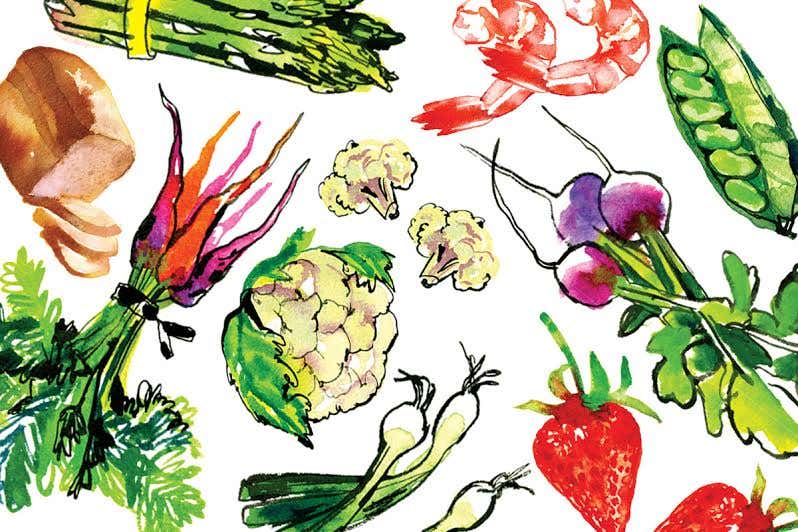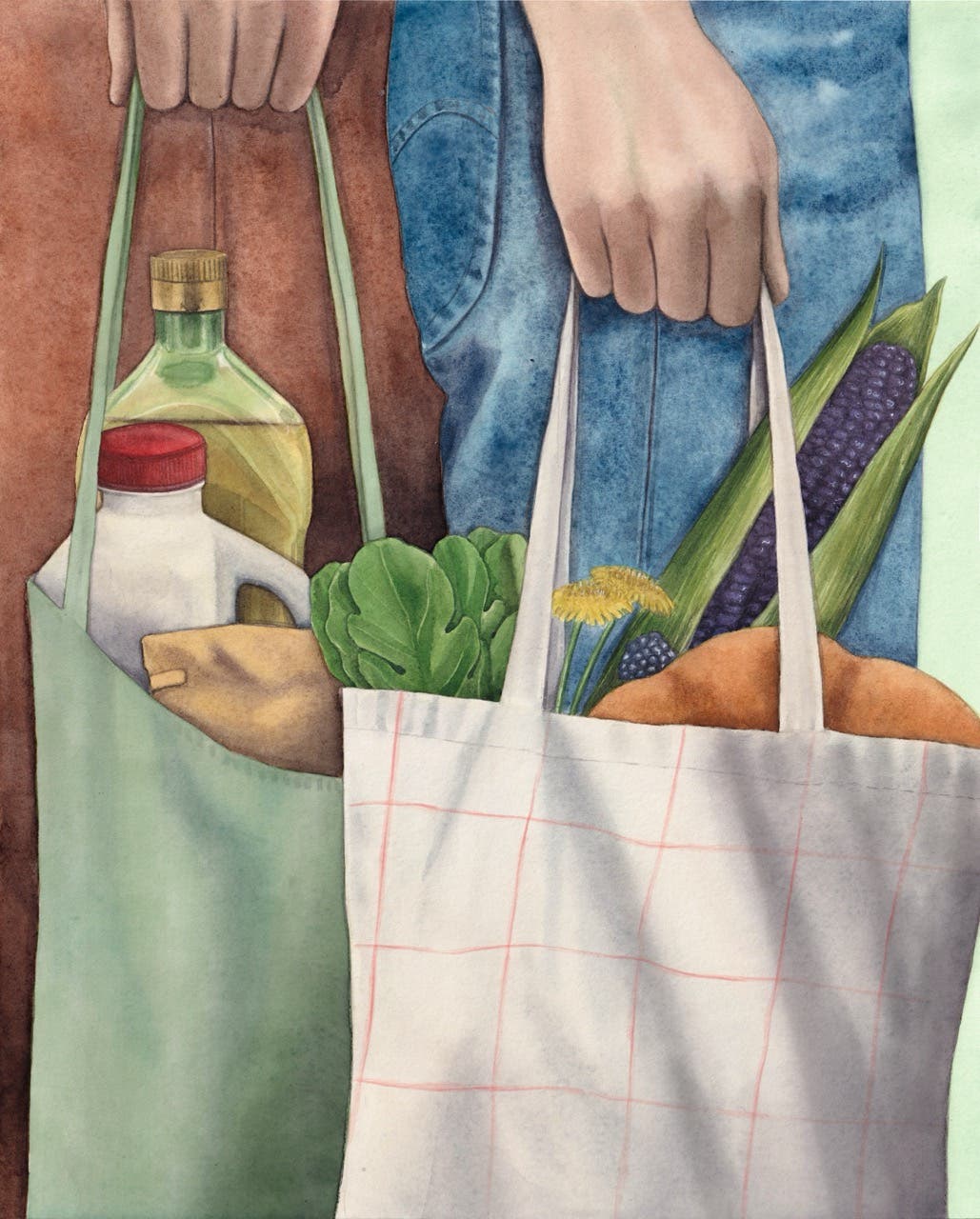
The Italian Torta
In the wooded mountains of the Riviera, savory vegetable pies are more traditional than pasta.
On a terraced hillside in the Valle Argentina, above Sanremo, on the outskirts of Triora—once a medieval Ligurian city-state, now a small exurban town—two elderly Italian women, sisters named Adriana and Anna Saldo, are bickering good-naturedly over a large, flat, lidded cast-iron pan perched on a little tripod over a smoky, crackling fire of vine cuttings and twigs. "Every time you poke the fire, that side of the torta always burns," scolds one. "No, it's your fault," counters the other. "It's because when you picked up the pan, you didn't put it down again properly."
A torta (plural: torte) is an Italian pie—usually a savory one, at least in this part of the Mediterranean—consisting of a filling (often based on vegetables) enclosed in thin dough and baked in an oven or cooked over an open fire. The notion of savory pies is ancient, perhaps dating to the Mesopotamians. The Egyptians, Greeks, and Romans all ate something similar. More recently, torte figured prominently in the sophisticated cooking of the courts of Naples and (as tourtes) in the classical kitchens of France. Torte of various designs are made all over Italy today, but the Ligurians seem to produce the thing in its purest form—just dough and filling, unelaborated, undecorated, elemental. The only potentially complex Ligurian torta, in fact, is torta pasqualina, or Eastertide torta, which is filled with either artichokes or Swiss chard (mixed with eggs, cheese, and herbs). Traditionally, torta pasqualina was made with 33 layers of dough—ten on the bottom and 23 on the top—to symbolize the 33 years of Christ's life. According to Genoese politician and gastronome Paolo Emilio Taviani, when Nietzsche lived on Genoa's piazza Portello in the 1880s, he thought it worth devoting an afternoon to learning how to prepare a torta pasqualina from his aged landlady. (I found a superb, if distinctly non-Genoese, interpretation of this specialty, under the name tourte de paques, at Franck Cerutti's now-vanished Don Camillo in Nice.)
The torta that Adriana and Anna are preparing over an open fire in Triora is far simpler, and more typical. In Sandro and Erica Oddo's comfortable apartment just down the hill—Adriana is Sandro's mother, Anna his aunt—the women have assembled the torta earlier from thin sheets of dough filled with a mixture of Swiss chard and potatoes bound with eggs. Usually they bake in the oven—but today, at my request, they're doing it the old-fashioned way, in the garden. "The open fire produces a very good torta," says Adriana. "You can smell when it's cooked," adds Anna.
After the torta has been on the fire for about 25 minutes, Adriana and Anna agree—more or less—that it is done. Holding the pan with several thicknesses of kitchen towel, Erica carries it inside and uncovers it. The torta, though its top is a bit blackened and slightly wizened, seems evenly cooked. After the pie has cooled for a few minutes, the women cut it into huge wedges, and we sit down to eat. It is delicious—the filling is pleasantly sharp but creamy, the crust vaguely smoky—and truly savory. It is also an endangered species: Sandro Oddo, who is a serious student of local history, folklore, and cuisine, tells me that until 1994, Triora held an annual torta-making contest. The event has now been permanently canceled, however. In its last two years, he says, only two women bothered to enter. "It wasn't much of a competition," adds Erica Oddo, rather sadly. The art is being lost.
The Italian Riviera—the coast of Liguria, extending about 100 miles in either direction from Genoa and touching both Tuscany and the French border—has a reputation for glamour, wealth, indulgence. Just a mile or two inland, however, up into the steep, wooded mountains, furrowed with river valleys, that continue on into Piedmont, life has been poor and harsh for centuries—and for centuries local peasants subsisted principally on chestnuts (often ground into flour), wild greens and mushrooms, simple soups, occasional game…and torte.
"In the old days," says Sandro Oddo, "people in the mountains ate torte every day. Pasta was a rarity." Pasta is filling and comparatively inexpensive, but because little wheat grows in the Ligurian _entroterra _(hinterland)—or anywhere else in the region—flour was expensive, and pasta was usually purchased instead of being made at home. A pound or less of flour could be stretched, however, into a thin-doughed torta (with the addition of wild greens or mushrooms, for instance, bound with some eggs from the barnyard and some homemade cheese) to feed eight or ten. The prevalence of torte in this region wasn't originally a matter of gastronomic preference; it was a matter of survival.
A few miles downhill from Triora, in the mountainside village of Castel Vittorio, a glowingly robust restaurant owner named Mara Allavena (who was born in the region) makes definitive torte in a slightly different style at her modest Osteria del Portico. The Osteria is the kind of village eatery where men gather at a tiny bar just inside the front door to drink wine and grappa and watch soccer on a pint-size television and where a dozen kids from the local elementary school file in with their teacher every day for lunch. In the unassuming dining room, with its view down into the Val di Nervia and across to the hills beyond, Allavena proposes a number of local specialties. There is always a silky, pinkish puree as an antipasto (it defies analysis at first, but when I learn that it's tuna, potatoes, and mayonnaise put through a food processor, I'm not surprised), as well as pasta dishes, snails, and simple roasted meats and game (including local wild boar)—plus, sometimes, such obscure regional specialties as gran pistau (a dish of long-cooked wheatberries flavored with leeks and parmigiano-reggiano).
Allavena's real culinary claim to fame, however, is her way with torte. The style in this part of the entroterra is different from that of Triora and most of the rest of Liguria: Instead of many top and bottom layers, hers is made with a single oversize sheet of dough; the filling is placed in the middle and the edges are drawn up to the center in irregular pleats. She makes a chard-filled torta (like everybody else in every corner of Liguria, it seems), but her specialties are torta di patate, with its irresistible filling of pureed potatoes, and torta di polenta with spinach and herbs. She usually bakes her torte in a small oven in her little kitchen, but on special occasions, Allavena used to carry them down the street to the local communal oven. This is another reason torte were important in this region, she says: "The baker would cook it for you in the leftover heat after he'd finished his loaves." A delicious economy. Unfortunately, the oven closed down this year in response to new Italian safety laws. Another lost art.
Keep Reading
Continue to Next Story










